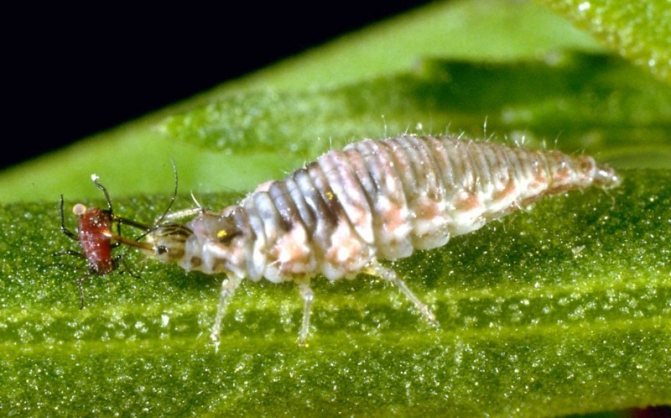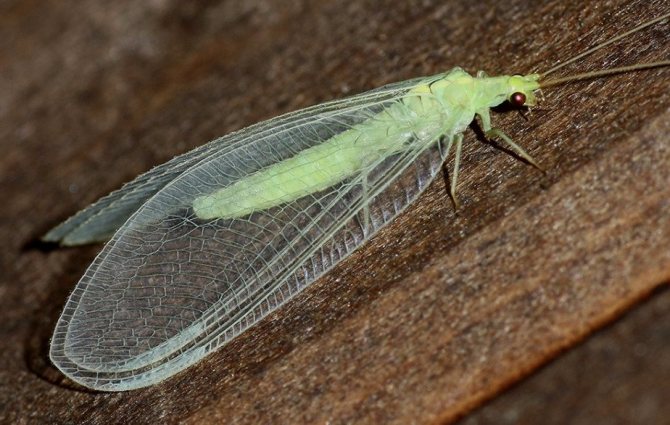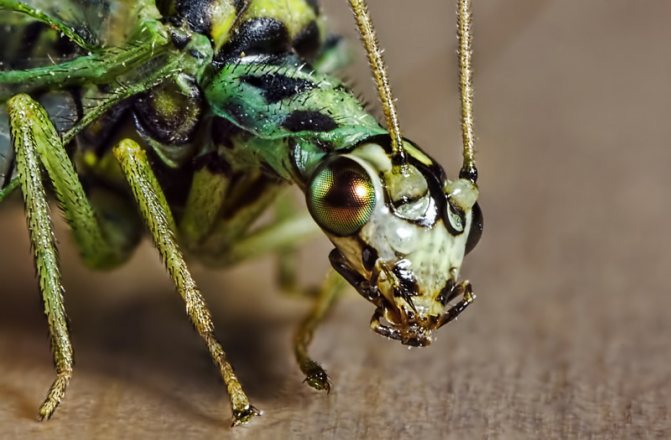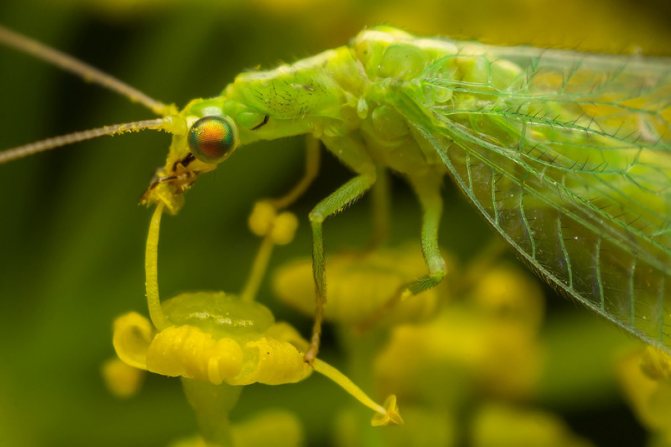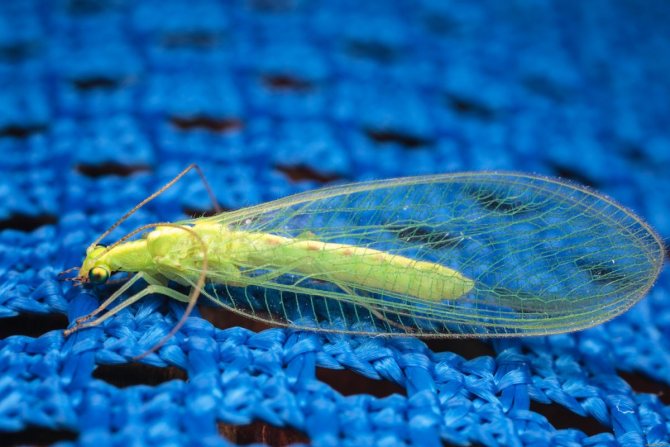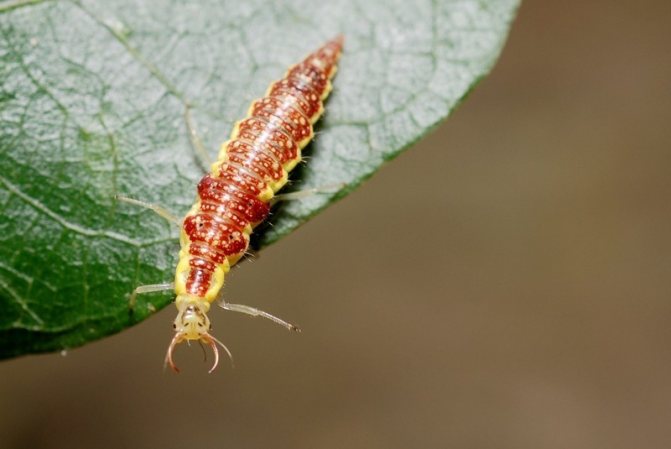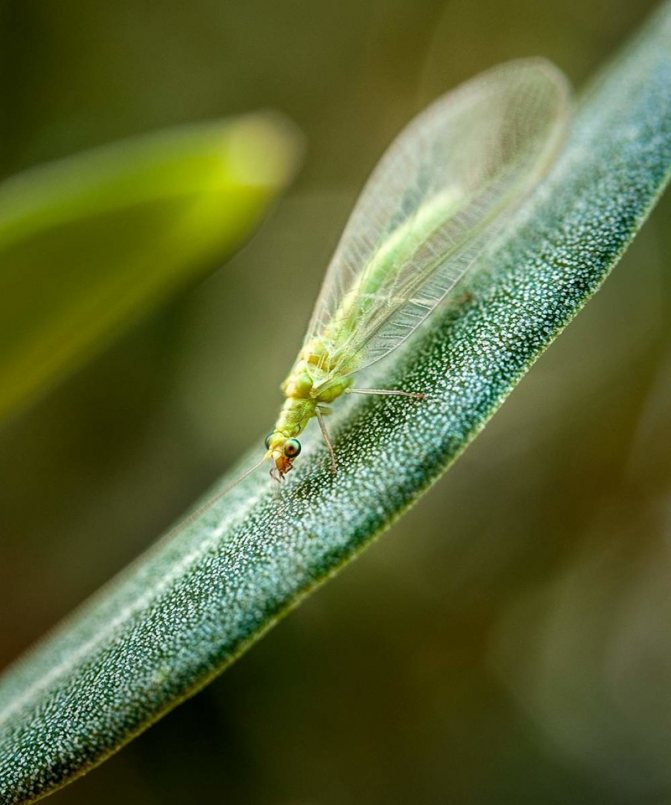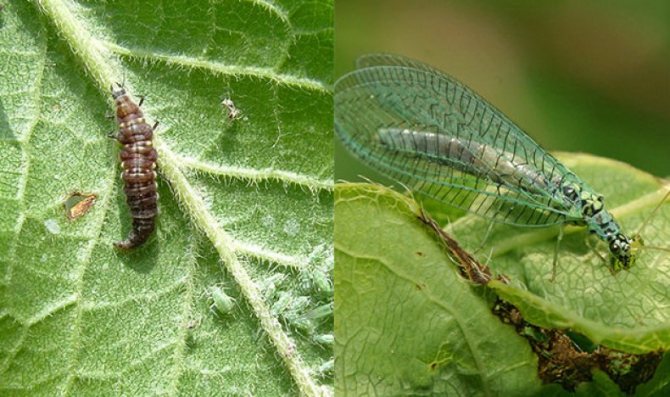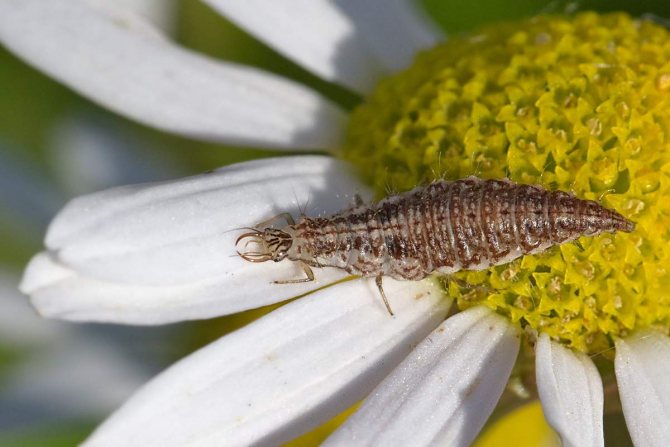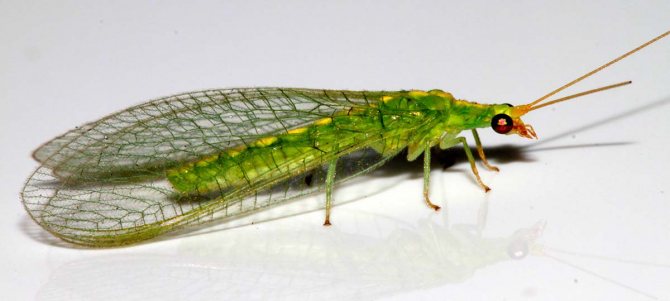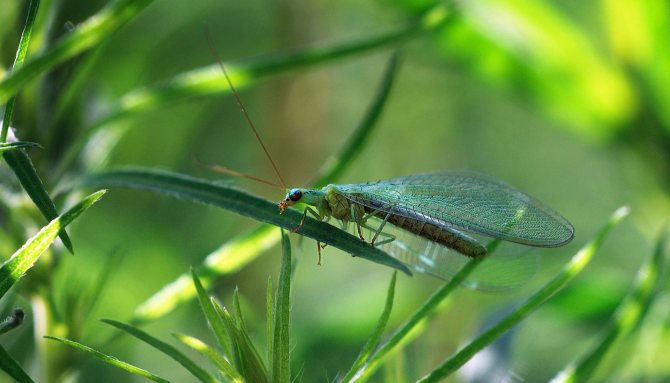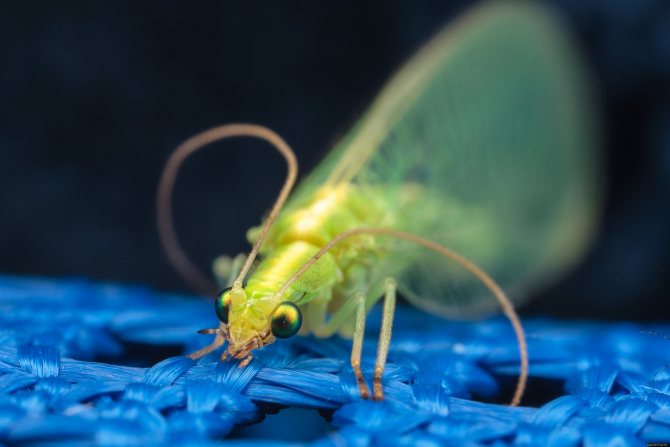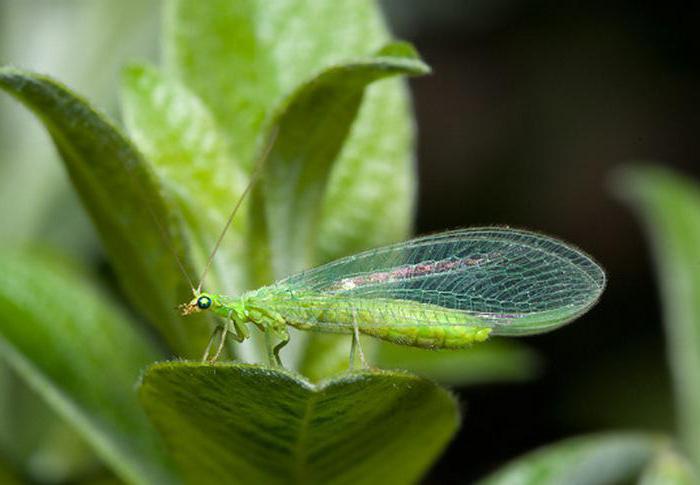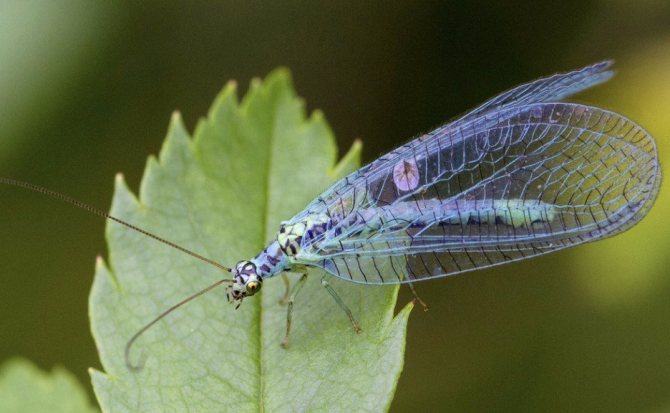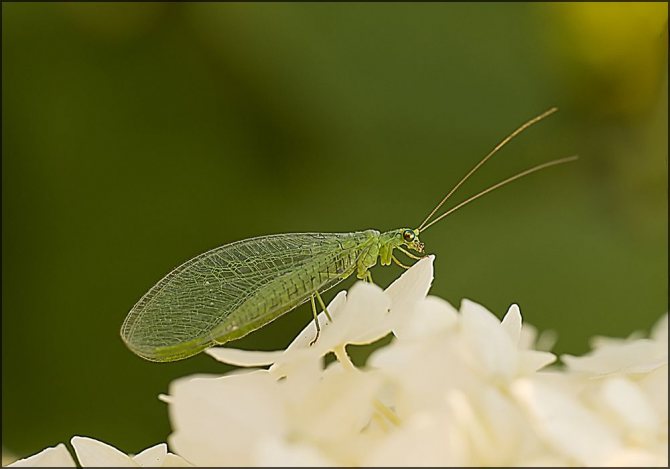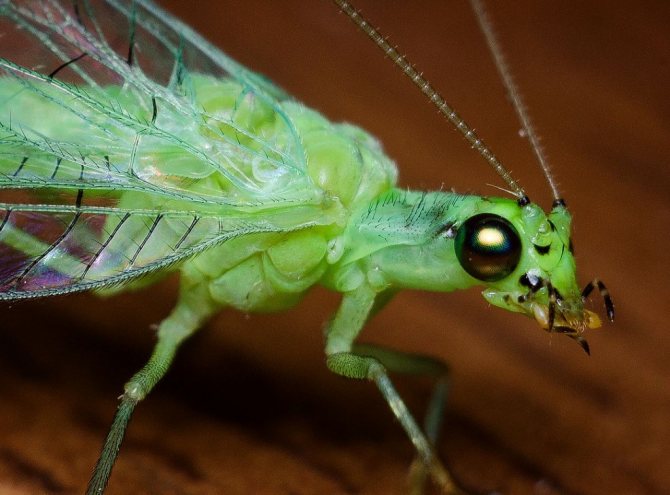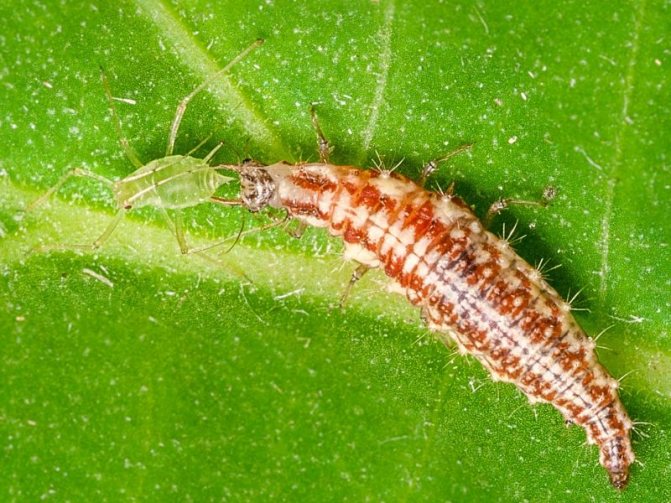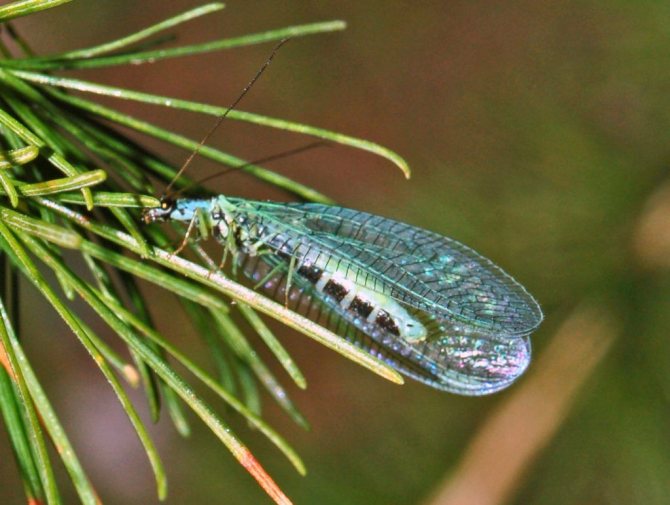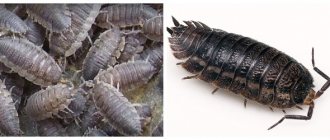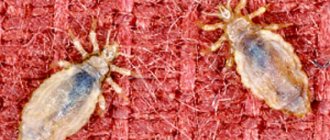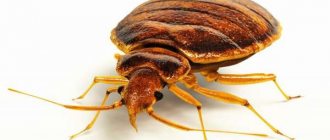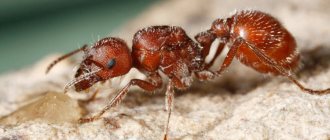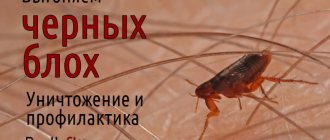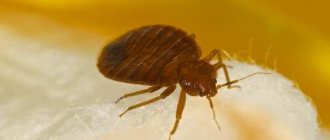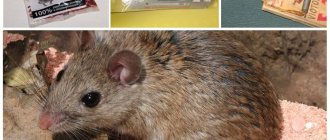Of the two thousand representatives of the entire family Chrysopidae, the most famous is the common lacewing, a small predatory insect whose wingspan can reach 3 cm. Its larvae, devouring pests, are of great benefit in agriculture. To this end, many gardeners specifically settle lacewing on their plots.
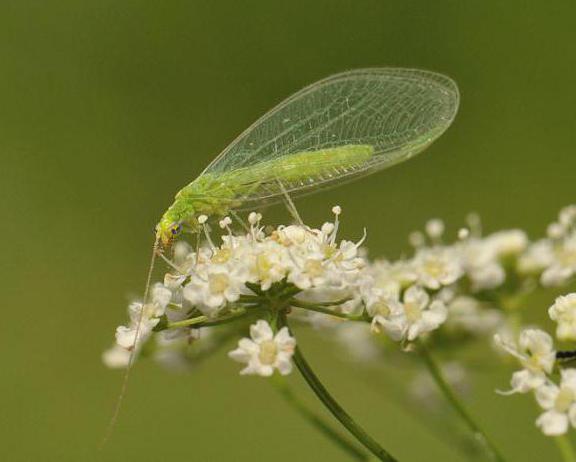
Appearance
This insect has large faceted eyes of gold color, for which it received such an interesting name. The body is green. A light green strip is clearly visible on its upper part.
The common lacewing Chrysopa perla has exquisite pale green wings. They are completely transparent, and many of the finest veins are clearly visible through them. The adult has a slender abdomen, three pairs of legs and long movable antennae.
The larva is light coffee in color, has sharp curved jaws, giving out a real predator in it. Small eyes can be seen on the wingless, worm-like body covered with warts and hairs. Its length is about 7 mm.
The common lacewing has a very good response to ultrasound. Hearing him, she instantly folds her wings and falls to the ground, thus saving herself from the bats.
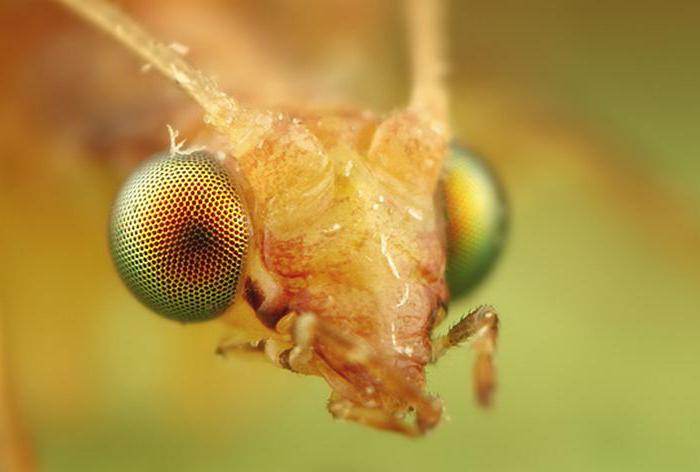

Insect description
The common lacewing is a green midge with transparent wings. It belongs to the genus Chrysoperla, whose representatives prefer to feed on other insects on both larvae and adult midges. It is most active at night, and during the day it prefers to hide in secluded corners.
To wait out the cold winter, midges fly into outbuildings and human houses. There, they climb into secluded places: for example, cracks in walls or furniture.
Reproduction
During her life, which lasts about 2 months, the female lacewing makes 2 clutches. Each of them contains 100-900 eggs.
Insect development stages:
- Eggs. They are attached to the underside of the leaves by fine threads. At first, the eggs are green, but then gradually darken.
- Larvae. They appear after a few days and begin to eat actively. Their brown or reddish body is no more than 7 mm long. They have a well-developed jaw apparatus. When attacking the victim, paralytic poison is injected into its body.
- Pupa, which, after a few molts, becomes an adult fleur-eater.
- Imago, ready to reproduce.
Larvae and adults are so voracious that cases of cannibalism are not uncommon among the species. In the middle zone, only one generation of lacewings manages to appear per year, and in the southern regions it can manage to develop up to 4 generations.
Habitat
This insect is distributed in various regions - practically throughout Europe, with the exception of the northern part, In North Africa, South-West Asia. The main places where it can be found are mixed forests, parks and gardens.
The common lacewing, conserving reserves of nutrients, hibernates in some crevice or hollow of a tree. And also at this time of the year it can be found in a room, somewhere behind a wardrobe or a painting.
In spring, insects fly to hazel, willows and blooming gardens.
Beneficial insect. Ladybug, ground beetle, bee, lacewing. Garden and vegetable garden defenders
This insect is simply bathed in glory. Everyone knows that beneficial insects bees are human helpers. They not only actively participate in the pollination process, but also provide many useful products: honey, wax, propolis and much more.
Many combine gardening and beekeeping. The hives can be installed directly in the garden or nearby. Apple, pear, plum, gooseberry and some other horticultural crops could not bear fruit without the help of bees.
It is difficult to overestimate the merits of this insect. They do most of the pollination work.
In addition to domestic bees, there are also wild bees. They settle in shady forests and plantings and sometimes also fly into gardens in search of nectar. It is difficult to domesticate them, and there is no point in this - it is easier to breed them at home.
Development
For a rather short life, which is about 2 months, the common lacewing makes two clutches, usually not far from the places where aphids live. Each of them can contain from 100 to 900 eggs. They are green at first, but gradually darken.
The eggs are attached to a narrow leg up to 3 mm long and then become similar to some rudiments of mushrooms. To make such a stem, the lacewing presses the end of the abdomen to the leaf and distributes a thick, rapidly solidifying drop of liquid, which it then draws out, while lifting the abdomen.
The next stage is the larva. It develops within 2-3 weeks. Hatching, it immediately molts and begins to feed. It can eat almost a hundred aphids in a day.
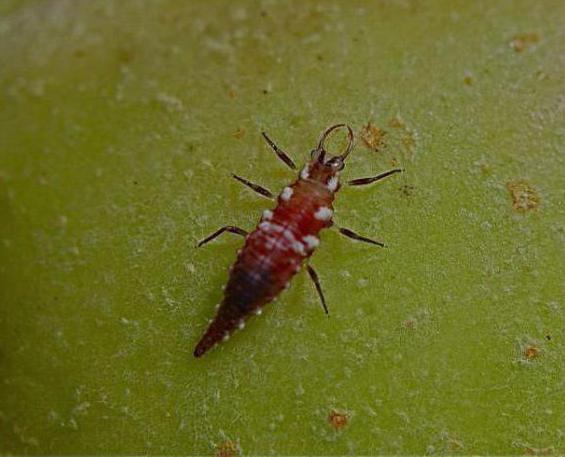

Further, using its silk, the larva weaves an oval cocoon and passes to the next stage - prepupae. It is practically no different, but it already has the makings of two pairs of wings.
During the next molt (after 3-4 days) it turns into a pupa, which in about a week cuts out a certain door near the cell and crawls out. Then it is attached to the cocoon and after five minutes a beautiful creature is born, which soon becomes a flair.
In warm regions, the common lacewing develops rapidly, and that is why four generations are replaced in one year, in the subtropical zone it reaches eight. But in the north, only one offspring appears.
Life cycle features
If the average daily temperature is 26 ° C, the insect's life cycle lasts 25-30 days. The female can lay 100-900 eggs on the leaves of plants - this usually happens in the foci of pests. The larva goes through three stages of development in 2-3 weeks and turns into pupae. The ratio of females to males in the population is approximately 1: 1.
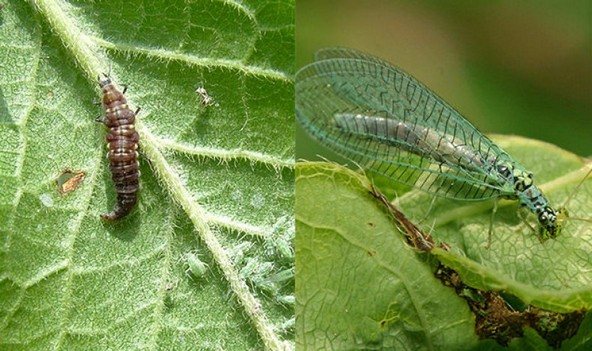

Adult insects usually feed on honeydew or nectar. The larvae feed on aphids, on which they usually parasitize. Insects appear in the spring, when the air temperature reaches about 10 ° C. At this time, they get out of winter shelters - crevices, cracks, rooms, crawl out from under the bark and other quiet secluded places.
Flernits are most active in the evening, when dusk falls. They are attracted by electric light, so they can fly into a house or other lit rooms. They do not fly high, despite the presence of 2 pairs of wings. During the daytime, lacewings usually hide under leaves, grass and other shaded areas. They move only if disturbed.
Food
The larvae of this species, in addition to aphids, also feed on worms, various plant and spider mites, caterpillars, insect eggs, including the Colorado potato beetle. But nevertheless, the most favorite delicacy for them is the pea aphid. Apparently, due to the fact that the latter contains a lot of protein in its diet.
And in order to disguise itself and protect itself from the sun, the larva takes the sucked victim's skin on its back, adding grains of sand, pieces of moss, bark, and constructs a cap for itself.
The adult common lacewing collects pollen from flowers, leaves and stems. This interesting fact was proved by the scientist E.K. Grinfeld, who put several pieces of butterflies in a jar and then poured pollen there. Insects knocked on the glass and lost the scales of their wings. When Greenfeld released them, he put down a small bouquet, and then let in the lacewing. Later, in their intestines, he found remnants of scales along with pollen.
That is why fliernits have a beneficial effect on plants by cross-pollination. They also collect dew, drink juice from the fruits of apples, pears and grapes.
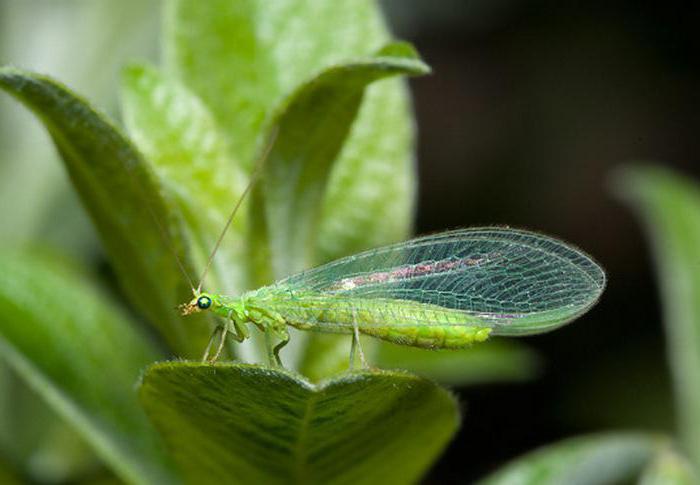

However, not all individuals of this species are civilians. Many of them retain their larval predilections and go hunting. They destroy aphids and various pests much more than the larvae themselves, since they live much longer than them.
The reasons for the appearance of a lacewing in the apartment
For them, the house where the person lives is not their natural habitat. It is very difficult for her to find food here. There are several main reasons for the presence of an insect in an apartment or house:
- Lowering the air temperature. The midge feels good if the air temperature is not less than 10 degrees. When it is lowered, it will seek a warm refuge for itself.
- The emergence of aphids and other pests on domestic plants. This midge flies everywhere in search of food and can get into the apartment, attracted by a large number of aphids on the flowers of the balcony or windowsill.
- Accidental hit. It can be brought from the street on flowers, clothes, fruits or various other items.
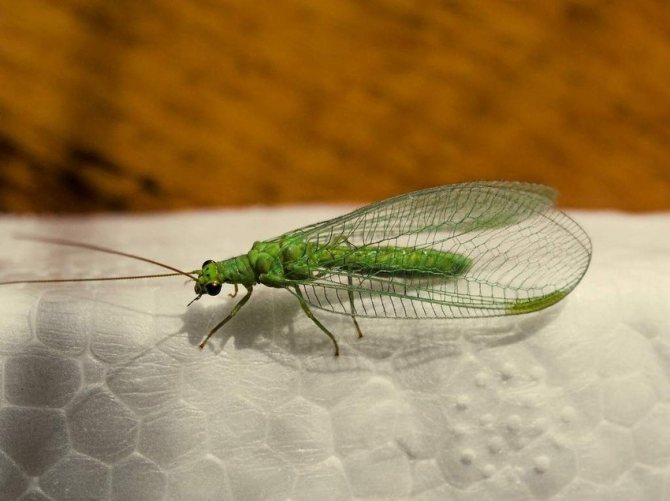

These midges will not do much harm in the apartment, especially if only a few insects have arrived. A large number of them will bring tangible discomfort. Someone simply cannot bear to fly midges in their apartment. The booger is in complete rest all day. With the onset of evening, she flies out and likes to be on the ceiling, curtains, or sits on a person, which is very unpleasant.
Benefits for humans
The lacewing larva is used in pest control, and the effectiveness depends on the population size of the latter. The best result is achieved with a low (medium) insect density.
The common lacewing, whose photo is in this article, settles up to 3-4 times a month in such a way that there are from 10 to 15 insects per square meter. With an increase in the number of pests, the density of settlement of lacewing increases, since with a lack of food, voracious larvae can attack beneficial insects or their own relatives.
How to get rid of green midges
The insect is not harmful, therefore, first, humane methods of dealing with it should be applied. It is advisable to take advantage of the natural features of the lacewing behavior.
She prefers a nocturnal way of existence, which means we are trying to "drive her out" from the house at night or in the evening. To do this, turn off the light in the house, and illuminate the street. It is advisable to open all windows wide open. The vents will not be enough. The eyes of the midge will not see the window pane, and it will beat unsuccessfully against it, never leaving the room.
If the humane method did not work, you have to use more radical methods:
- We turn on the vacuum cleaner and "clean up" insects with it;
- Chemical sprayers. Usually, they only affect adults, which die immediately. The processing of the premises is carried out with tightly closed windows. Then it must be well ventilated, so harmful fumes can harm not only bugs, but also people. Ordinary Dichlorvos is suitable for processing;
- Fumigators. This modern remedy for mosquitoes and other harmful insects targets lacewing. Especially if an ultrasonic device is used. Having caught the vibration, the midge freezes and falls to the floor.This natural feature helps the lacewing to survive in wildlife, fleeing from its main enemies - bats.
All these methods do not work on insect larvae and eggs. Consequently, after a while, offspring may appear. In an apartment, this happens extremely rarely, since it is difficult for a lacewing to find a source of food for future larvae.
You should inspect the room, eggs can be located on houseplants. They are very small, oval, light green in color. A leaf with larvae or eggs is torn off and destroyed.
Komachi can fly into the house, attracted by houseplants. To prevent this from happening, it is necessary to spray home flowers with the following solution: one pack of vanilla sugar is diluted in one liter of water. In summer, when the lacewing is especially active, this spraying should be done at least once a week.
Not very aesthetically pleasing, but sticky traps work effectively. They are placed near windows and houseplants. The insect sticks to the sticky surface and dies almost immediately. The device is replaced with a new one as insects accumulate.
If a lot of green midges are bred in a wooden house, this can serve as a signal for the appearance of the larvae of the woodworm beetle. This insect is very harmful, gradually destroying wooden floors. After the destruction of the larvae of the beetle, the lacewing can "voluntarily" leave the house through the windows or the ventilation system.
There are several more cardinal ways to get rid of an insect:
- Pesticide. The leaves of domestic plants are treated with insecticidal agents. Under its influence, larvae and adults die;
- The room temperature rises. Close windows and doors and turn on all heaters in the house. The bug does not tolerate high temperatures and dies very quickly.
Before using harsh insect control methods, you should use alternative ones. The insect does more good than harm. In many countries, there are specialized farms for breeding lacewings, which are then used as a unique means of controlling agricultural pests. A house or apartment is not a natural habitat for this cute insect, just help it move in.
A number of obvious advantages for gardeners can rarely please houseplant owners.
Often, midges can enter the house along with plants that were brought into the house from the street (begonias, amaryllis, violets, aloe and others). When these plants are damaged by pests, the lacewing is engaged in their destruction, but this does not add joy to the owners of the houses.
With building materials, in particular wood. In the winter, midges often crawl into crevices and thus can get into the house.
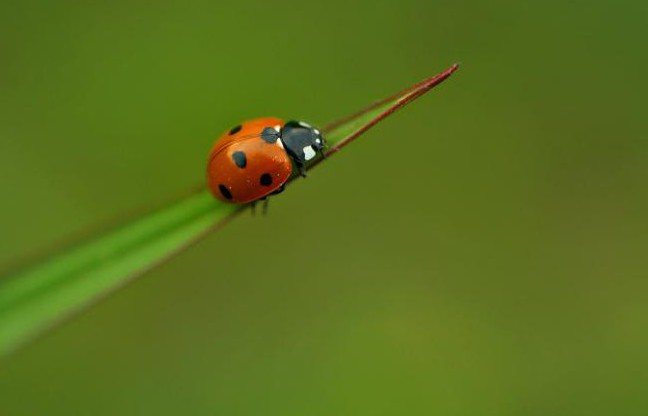

Regardless of the method of getting into the room, many people prefer to get rid of them as soon as possible.
The main methods of struggle include:
- In the evening, open the window by turning off the light in the house and turning it on outside. Since insects are attracted by electric light, they will fly towards it, leaving the building;
- If you need to get rid of insects quickly, you can use a vacuum cleaner. To do this, it is enough to collect insects with a device;
- The use of special sprays, in particular "Dichlorvos". It is important to take aerosols when there are no people in the house;
- If lacewing has appeared on the plant, it can be sprayed with a solution of fifty grams of vanillin and one liter of water;
- Insects of this species do not tolerate high temperatures very badly, so you can fight them using a fireplace or convector.
However, it is worth remembering that the lacewing is a plant protector and, before proceeding to destruction, it is recommended to remember this and choose the most humane method of struggle.
Lacewings are small insects that provide many benefits.Destroying various pests, these insects do no harm to plants. The only drawback of these midges is the fact that when they enter the house, they can cause some discomfort for the owners. If necessary, dealing with a problem in the building is easy.
We suggest that you familiarize yourself with: Who eats the Colorado potato beetle: natural enemies of the minke whale
Despite its useful qualities, lacewing is one of those insects that can appear in the house, which brings discomfort to the owners and makes them look for a solution to how to get rid of it.
This can happen for a number of reasons. For example, a fleece can live indoors during the winter cold. This also happens when pests start on indoor plants, and, accordingly, the lacewing will be engaged in their destruction. And another common option is repair work, as a result of which building materials were brought into the country house, and this midge moved with them.
- The easiest way is to open the window in the evening. First of all, you need to open windows or doors, turn off the light in the house, and turn it on outside. Fleurnice will certainly fly to the electric light, thereby relieving the owners of the country house from their presence.
- A less humane way is a vacuum cleaner. This method should be used when the result is needed immediately.
- There are also special flying insect sprays on the market. Aerosol can be used to etch fleece. Suitable, for example, "Dichlorvos".
- If an insect has appeared on a house plant, you can treat it with a solution consisting of 50 g of vanillin and 1 liter of water. Lacewing does not harm houseplants, but it can spread throughout your home.
- Fleurnice does not tolerate heat. If you create hot conditions in the house, all insects will die. This can be done using a fireplace, convector and other things.
Before applying the cardinal methods that destroy the lacewing, you should still remember all the useful features that it possesses, and, if possible, choose a more humane method.


The lacewing is a beneficial insect that eats aphids, thereby helping to preserve vegetation at their summer cottage. But there are times when insects appear in a residential building, causing discomfort to its inhabitants.
These ephemeral insects were named "lacewing" for their amazingly beautiful, golden eyes.
Trichogramma
This microscopic parasitic insect is of great benefit precisely because of its lifestyle. Trichogramma larvae can live only at the expense of other organisms - eggs and larvae of other insects.
It is noteworthy that Trichogramma selects only pest clutches for parasitism. This beneficial insect is dangerous for more than 90 species of harmful butterflies that feed on leaves and fruits.
Knowledge of the laws of nature helps to make life much easier and significantly reduce the cost of housekeeping. Try to make friends with little garden helpers, do not drive them from the site or destroy them, and thanks to them you can get an excellent harvest without using chemistry.
Aphid lion
Another tireless aphid fighter is a relative of the lacewing. The aphid lion and its larvae feed exclusively on aphids, so that its populations do not grow to gigantic proportions. These insects are used not only by summer residents, but also by professional farms. In specialized stores, you can even purchase clutches of eggs of this insect, which can later be placed in greenhouses and outdoors.
Another tireless aphid fighter is a relative of the lacewing. The aphid lion and its larvae feed exclusively on aphids, so that its populations do not grow to gigantic proportions.These insects are used not only by summer residents, but also by professional farms. In specialized stores, you can even purchase clutches of eggs of this insect, which can later be placed in greenhouses and outdoors.
Life activity
When the owners know the peculiarities of the lifestyle and behavior of the fliernits, then it will be easier for them to protect their homes from their invasion. It will also help gardeners, on the contrary, create favorable conditions for their breeding. Thus, the ordinary lacewing has unique behavioral characteristics. Here is some of them:
- the maximum activity of adults is in the evening;
- does not tolerate prolonged exposure to direct sunlight;
- settles in shady and damp places: under leaves or in the grass;
- midges begin to crawl out of their shelters in the spring at temperatures above 10 ° C;
- they flock to the bright light of electric lamps, thereby penetrating the house;
- lay several dozen eggs (on long threads) near aphid colonies.
The larvae spend winter in attics, in the crevices of houses or under the bark of trees. If the owners want to get rid of them, then you need to make an effort to pull them out of there.
These "defenders" can be found in a personal plot or vegetable garden. Those who are engaged in greenhouses should also be attentive to the appearance of flares. All the same, experts recommend even adding these "orderlies" to your vegetable garden, garden or greenhouse. They will help get rid of dozens of pests.
Diet
In nature, there are two types of midges: predators and non-predatory individuals. The latter feed exclusively on inanimate organisms: the secretions of aphids, pollen or flower nectar. When asked if the lacewing is a pest or protector, it can be answered unequivocally that it acts for the benefit of gardeners. Its larvae eat over 80 types of pests, such as:
- caterpillars;
- spider mites and other types of mites;
- shields;
- aphids and their larvae;
- moths;
- Colorado potato beetle eggs;
- leafhoppers;
- woodworms;
- mole;
- poisonous spider cocoons.
The midge feeds only on soft-bodied insects. For 7 days, each individual kills up to 200 aphids, insects or eggs. Fecundity of females ranges from 200 to 400 eggs in their life.
What a way of life
During the day they fly reluctantly - these are nocturnal insects, often they are attracted by the light of lamps and street lamps. On sunny days, they prefer to sit in the grass in an atmosphere of moisture and coolness. Some species feed on pollen, nectar, others eat small insects and do not even disdain their own relatives.
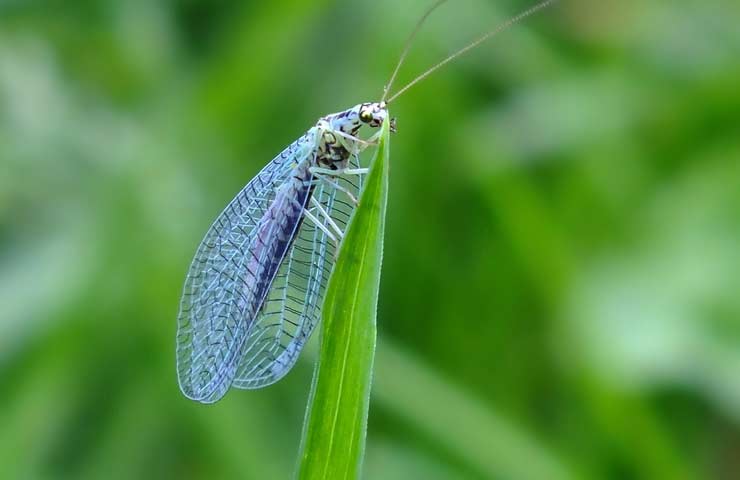

The common lacewing flies quickly, it is extremely voracious, it can destroy up to hundreds of plant pests per day, which makes it a desirable insect in gardens and vegetable gardens. Many specialists involved in plant cultivation practice breeding it in their garden.
The midge comes to life from hibernation at temperatures above 10 ° C; in arid and hot climates, it dies.

